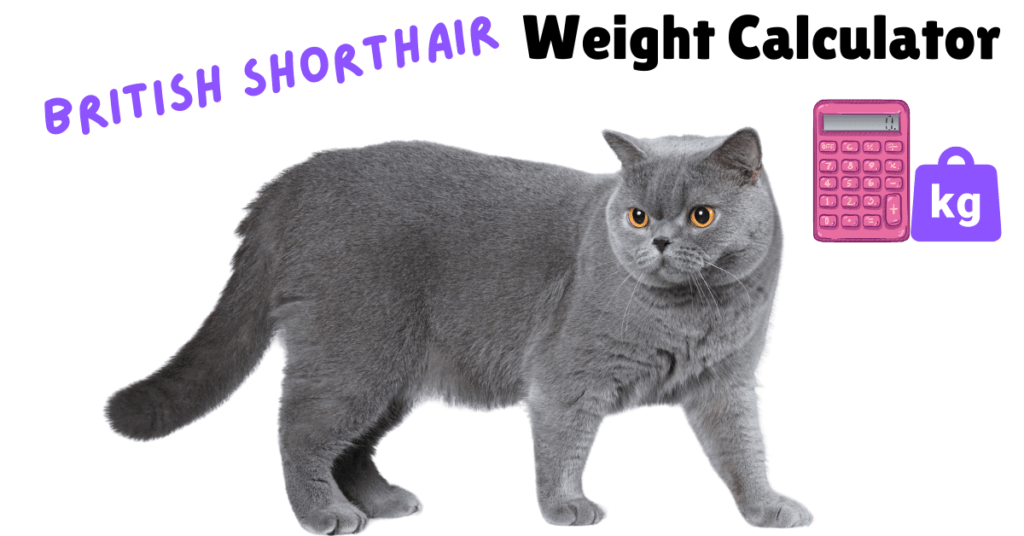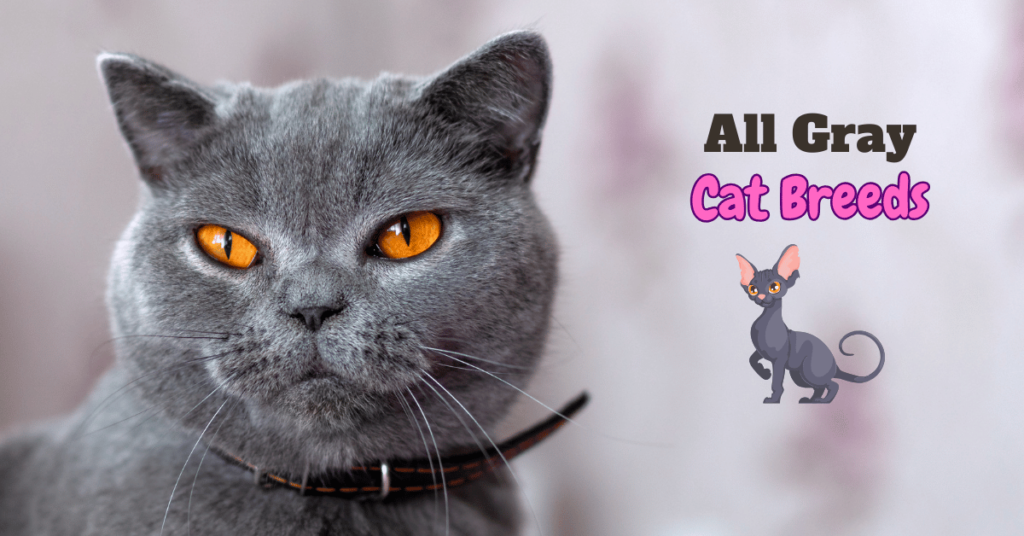This post contains affiliate links and I will be compensated if you make a purchase after clicking on my links.
Meet the British Shorthair: An Overview
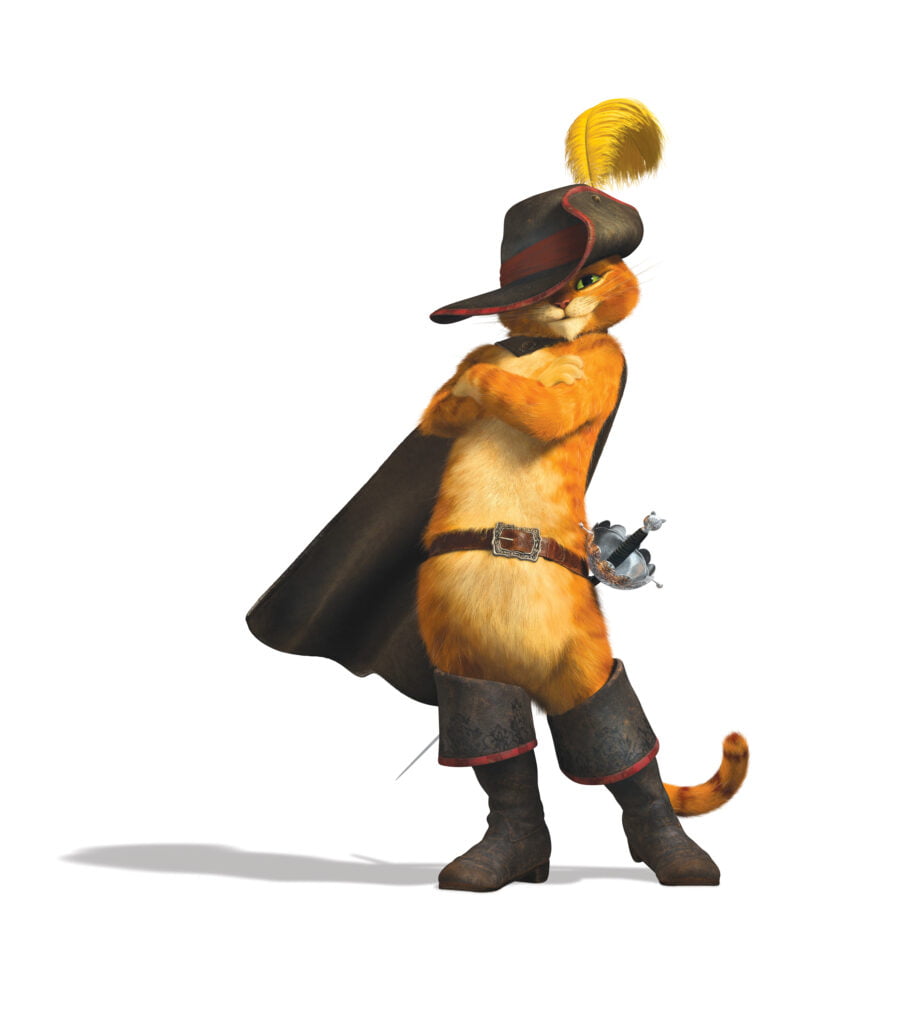
The British Shorthair cat breed sport a short, dense coat and a distinctive rounded head and face, giving them a teddy bear-like appearance. Originating from the United Kingdom, they have a rich history and are often affectionately referred to as British Blues, especially the iconic solid gray-blue variety.
With chubby cheeks and big green eyes, Puss in Boots is generally considered to be a British Shorthair (despite his Spanish accent). In the UK, British Shorthairs have held the title of the most popular pedigree cat since 2001. Their endearing looks and delightful temperament continue to win hearts all over the world.
In this comprehensive guide, we’ll delve into the history, physical characteristics, personality traits, health considerations, and care requirements of this charming breed.
History and Origin of the British Shorthair Cat Breed
The British Shorthair’s roots can be traced back to the domestic cats of Rome, brought to Britain during the Roman invasion. These hardy felines bred with native wildcats, resulting in a sturdy, resilient breed. Over the centuries, British Shorthairs became prized for their hunting skills and adaptability, thriving in various environments across the British Isles.

Originally shorthaired street cats, British Shorthairs were used for vermin control and quickly spread throughout the country as farm and street cats. Their calm and confident personalities soon prompted people to welcome them into their homes. In the late 1800s, a determined cat breeder named Harrison Weir began developing the British Shorthair officially by crossing different individual felines.
Official recognition came in 1871 when the breed was showcased at the first organized cat show at the Crystal Palace in London. Back then, the breed was often called the British Blue because blue (gray) was a very common color in the breed early on. The breed was first brought to the United States in the early 1900s and was recognized by the Cat Fanciers’ Association in 1980.
Physical Characteristics of the British Shorthair Cat Breed
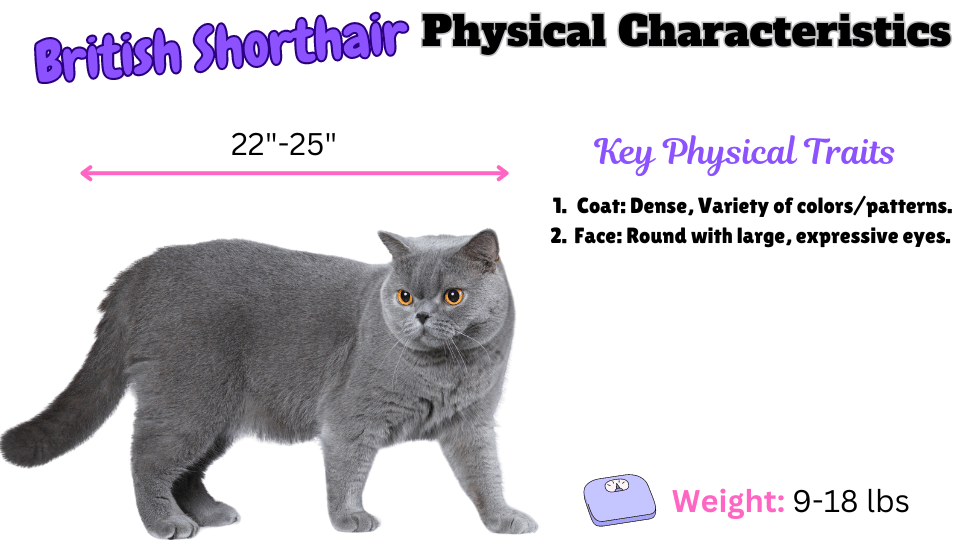
General Appearance
British Shorthairs, typically weighing between 9 and 18 pounds with males often on the larger side, are classified as a large cat breed.
These felines have a well-balanced, muscular build that exudes strength and robustness. They can grow up to 22 to 25 inches in body length. Their large, round eyes and chubby cheeks give them an endearing, teddy bear-like appearance.
Coat Colors and Patterns
One of the most striking features of the British Shorthair is its dense, plush coat. This breed comes in a wide variety of colors and patterns, making them a true feast for the eyes.
While the “British Blue” is the most iconic—think of a stunning solid gray-blue hue—British Shorthairs can also be found in a rainbow of other colors and patterns, including tabby, bicolor, tortoiseshell, calico, and more. Imagine having a cat that looks like a piece of art!
Distinctive Features
British Shorthairs have a round, wide-set face with large, expressive eyes that can be copper (often appearing orange), blue, green, gold, or even odd-eyed (eyes of two different colors). Their round cheeks and firm chin make them look like they’re always smiling.
Their coat is short, very dense, and crisp to the touch—perfect for those cozy cuddle sessions. Despite its thickness, the coat is not double-coated or woolly. These cats have a broad chest, strong legs, and a thick tail, all contributing to their overall robust and powerful appearance. British Shorthairs typically reach their final size and weight between 3 and 5 years old.
Personality and Temperament of the British Shorthair Cats
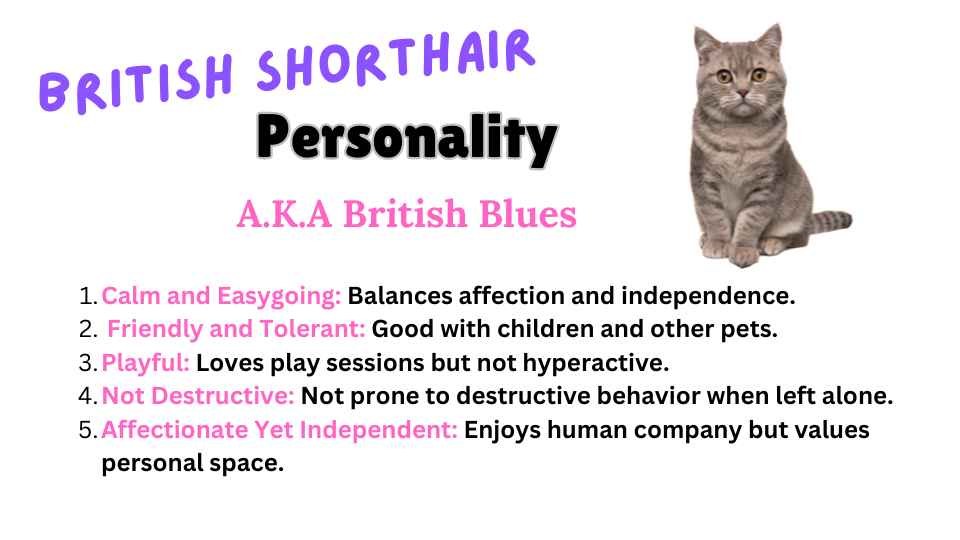
British Shorthairs enjoy both companionship and solitude, earning them a spot on the list of breeds that thrive alone. They offer affection without being clingy and appreciate occasional play. Their laid-back nature makes them ideal for quieter households.
When it comes to interacting with humans and other pets, British Shorthairs are friendly and tolerant. They get along well with children and other animals, including dogs, as long as they are properly introduced.
Their relaxed demeanor makes them fantastic family pets, treating everyone in the household like a good friend. They might take a little time to warm up to strangers, preferring to observe from a distance before jumping into the fray.
British Shorthairs are social but also value their personal space, this makes them particularly well-suited for homes with older children or child-free households, as they aren’t very forgiving of young children who haven’t yet learned to respect a cat’s boundaries.
Pro Tip: British Blue cats aren’t the biggest fans of being picked up. They generally prefer a hands-off approach when interacting with their human companions. Picking them up can make them feel vulnerable and uncomfortable.
Health and Lifespan
British Shorthairs are generally healthy, but like all breeds, they can be prone to certain genetic conditions. Let’s explore some of the common health issues you might encounter.
- Hypertrophic Cardiomyopathy (HCM): A heart condition that can sometimes affect British Shorthairs.
- Polycystic Kidney Disease (PKD): A genetic disorder that can lead to kidney failure.
- Obesity: Prone to weight gain due to their laid-back nature.
- Urinary Tract Issues: Can arise without proper diet and hydration.
- Kidney Problems: Regular vet check-ups and a balanced diet can help manage these.
With proper care, British Shorthairs can live between 12 and 20 years. Their longevity is influenced by factors such as genetics, diet, exercise, and regular veterinary care.
Fact: British Shorthairs fall under the flat-faced cat breeds category due to their brachycephalic trait. While this usually doesn’t cause chronic issues, it can lead to problems in extreme cases, such as breathing difficulties, persistent eye inflammation, trouble eating, and skin infections.
Care and Maintenance
Grooming Requirements
Keeping your British Shorthair looking fabulous isn’t just about showing off their plush, dense coat—it’s also key to their health and happiness. Here’s how to keep your furry friend in tip-top shape.
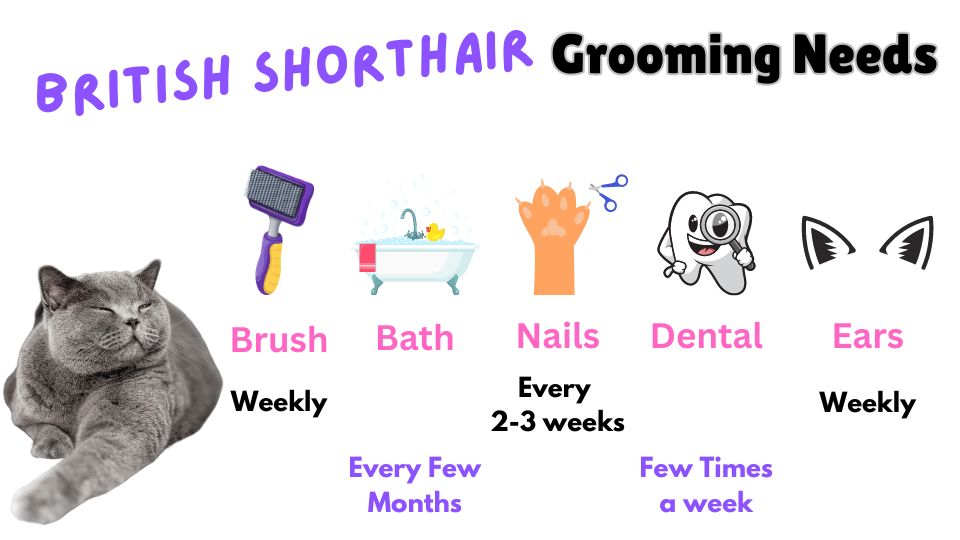
- Coat Care: British Shorthairs have a short, luxurious coat that needs regular brushing to prevent matting and reduce shedding. Brush about once a week using a soft slicker brush, and more frequently during periods of seasonal shedding to remove loose hair before it ends up all over the house.
- Nail Trimming: Trim their nails every two to three weeks to keep them from getting too long and sharp. Regular nail trimming helps prevent discomfort and potential injuries from overgrown nails.
- Dental Care: For their pearly whites, use cat-friendly toothbrushes and toothpaste to brush their teeth at least a few times a week. This helps prevent dental issues and keeps their breath fresh.
- Ear Checks: Don’t forget to check inside their ears weekly. Look out for any signs of dirt, wax buildup, or infection. A quick wipe with a damp cotton ball can help keep their ears clean and healthy.
- Bathing: British Shorthairs typically don’t require frequent baths. A bath every few months or when they get particularly dirty should suffice. Use a cat-friendly shampoo and ensure they are completely dry afterwards to prevent any skin issues.
Pro Tip: Regular brushing also gives you the chance to spot any signs of illness, like a greasy coat, which can be an early indicator that your cat isn’t feeling well.
Dietary Needs
Feeding your British Shorthair the right diet is crucial to keeping them healthy and happy. These cats are prone to obesity, so portion control is essential to prevent weight-related issues like diabetes and heart disease.
When choosing cat food, opt for high-quality options that meet their nutritional needs. Look for foods with named meats like chicken, turkey, fish, or beef as the main ingredient. These provide the protein your kitty needs to stay strong and active. Avoid fillers like corn, wheat, or soy, which offer little nutritional value and can contribute to weight gain.
Consider supplements like omega-3 fatty acids for a healthy coat and joint health. These can help keep their fur looking fabulous and support overall wellness.
Exercise and Enrichment
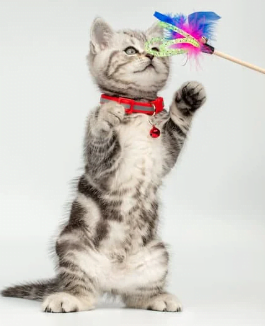
British Shorthairs might not be the most hyperactive cats, but they still need regular exercise to stay fit and healthy. Their laid-back nature means they’re more inclined toward short bursts of activity followed by long, luxurious naps.
To keep your British Shorthair in shape and mentally stimulated, engage them in daily interactive play sessions with at least half an hour of combined playtime.
Provide a variety of toys like feather wands, toy mice, and other favorites to keep them entertained. These playful interactions are great for bonding and help burn off any extra calories. Make sure your cat has plenty of things to climb and perch upon, such as cat trees, cat-friendly bookshelves, and kitty condos.
Scratching is another excellent way for British Shorthairs to get some exercise and mental enrichment. Set up several scratching areas around the house, including vertical scratchers like tall posts or cat trees and horizontal scratchers like cardboard or sisal mats. This will keep their claws in good condition and prevent them from scratching your furniture.
What is the Price of a British Shorthair Cat?
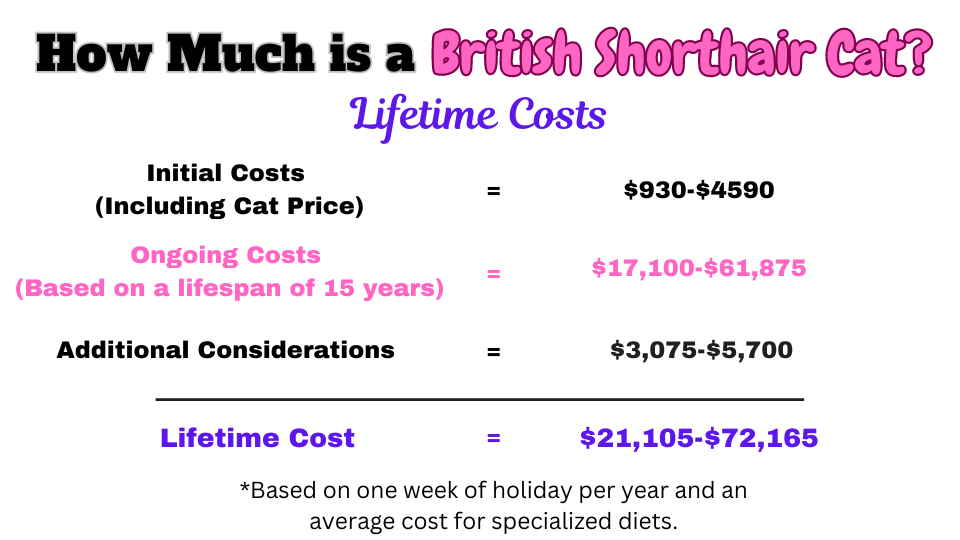
Owning a British Shorthair cat is a fulfilling experience, but it’s essential to be aware of the financial commitment it entails. From initial purchase or adoption fees and medical expenses to ongoing costs for food, grooming, and veterinary care, the expenses can add up quickly.
The total cost of owning a British Shorthair for a lifetime can vary widely, from approximately $21,105 on the lower end to around $72,165 for those opting for premium insurance and the most expensive options. While you can certainly spend less, these figures provide a realistic estimate of the potential costs.
Conclusion: Why Choose a British Shorthair?
The British Shorthair Cat Breed is a delightful blend of beauty, intelligence, and affection. Without being clingy, British Shorthairs are cool with strangers, though they might play it a bit aloof until they get to know you. These cats are all about their humans and love spending quality time with their favorite people.
Their presence brings joy and comfort, making them a beloved member of any family. Embrace the charm and elegance of the British Shorthair Cat Breed, and you’ll have a loyal, loving friend for years to come.
Meet Sean, a fintech whiz with a penchant for pet purrs and blockchain buzz. After a decade of fintech feats, Sean’s tech talents leaped from ledger lines to litter lines, driven by a passion for pets and a vision for a more connected pet care community. With three critter companions as co-pilots, Sean launched this blog to share a treasury of pet-friendly tech tips and tales.


